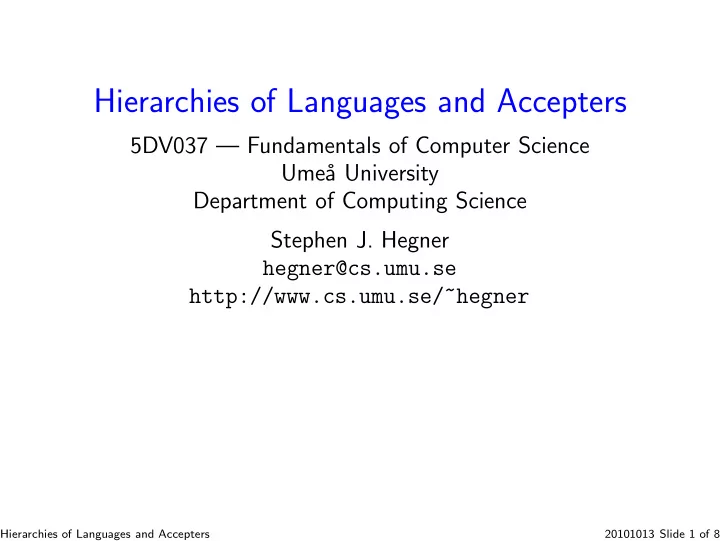

Hierarchies of Languages and Accepters 5DV037 — Fundamentals of Computer Science Ume˚ a University Department of Computing Science Stephen J. Hegner hegner@cs.umu.se http://www.cs.umu.se/~hegner Hierarchies of Languages and Accepters 20101013 Slide 1 of 8
Language Hierarchies • The classes of languages which have been studied in this course fit into a natural hierarchy. Example: The regular languages are a subset of the context-free languages. • In this presentation, such hierarchies will be formulated more carefully. • Two main hierarchies will be considered: • The Chomsky hierarchy : • formulated by the eminent linguist Noam Chomsky during the 1950’s; • somewhat incomplete but still important to know because of the widespread use of the associated terminology. • A full hierarchy summarizing all of the classes which have been studied in the course, together with an additional class present in the Chomsky hierarchy. Hierarchies of Languages and Accepters 20101013 Slide 2 of 8
The Classical Chomsky Hierarchy • This hierarchy was forwarded by Noam Chomsky during the 1950s. • It is summarized in the following table. Chomsky Modern Name Name Accepter Grammar type-3 regular DFA/NFA regular type-2 context free NPDA context free type-1 context sensitive LBA context sensitive type-0 Turing enumerable DTM/NDTM phrase structure • Each line in the table identifies a class which is a proper subset of the line below it. • The third line introduces unfamiliar notions. • LBA stands for linear-bounded automaton . • LBAs and context-sensitive grammars and languages will be introduced on the following slide. Hierarchies of Languages and Accepters 20101013 Slide 3 of 8
Context-Sensitive Grammars and Languages and LBAs • The grammar G = ( V , Σ , S , P ) is context sensitive (a CSG ) if every production α → β has the the property that Length( α ) ≤ Length( β ). • Thus, a CSG cannot have any null rules ( A → λ ). • Note that a context-free grammar is context sensitive provided it has no null rules. • A language L is context sensitive (a CSL ) if L \ { λ } is generated by a CSG. • Thus, the empty string is treated as a special case. • A linear-bounded automaton (or LBA ) is a DTM M which has the restriction that for any input of the form I� M , α � , the tape head is only allowed to scan and rewrite the tape squares containing α . • Thus, the memory allowed an LBA is bounded by the length of the input string. • This model is largely of historical interest and will not be studied further in this course. Hierarchies of Languages and Accepters 20101013 Slide 4 of 8
The Hierarchy Studied in the Course • Each row in the table is a proper subset of the row below it. Name Accepter Grammar regular language DFA/NFA regular grammar deterministic CFL DPDA LR(k) unambiguous CFL - unambiguous CFG CFL NPDA CFG CSL LBA CSG (Turing) decidable / recursive DTM/NDTM decider - Turing acceptable / recursively enumerable / semidecidable DTM/NDTM PSG Hierarchies of Languages and Accepters 20101013 Slide 5 of 8
Some Closure Results • L , L 1 , L 2 = language in the class; R = regular language. Name L 1 ∪ L 2 L 1 ∩ L 2 L ∩ R L regular language Y Y Y Y deterministic CFL N N Y Y unambiguous CFL N N N Y CFL Y N N Y CSL Y Y O U (Turing) decidable / recursive Y Y Y Y Turing acceptable / recursively enumerable / semidecidable Y Y N Y • O = Open problem, to the best of my knowledge. Hierarchies of Languages and Accepters 20101013 Slide 6 of 8
Some Decidability Results • D = decidable; N= undecidable. Name L = ∅ L = Σ ∗ L 1 = L 2 L 1 ∩ L 2 = ∅ regular language D D D D deterministic CFL D D D U unambiguous CFL D ? ? U CFL D U U U CSL D U U U (Turing) decidable / recursive D U U U Turing acceptable / recursively enumerable / semidecidable U U U U • ? = I am not sure, but I think that the answer is U. Hierarchies of Languages and Accepters 20101013 Slide 7 of 8
The Utility of a Formal Language Hierarchy Question: What is the practical use of such a hierarchy and all of the theoretical results? • All real computers have finite memory and thus are modelled using finite automata. Answer: Although undecidable problems become “decidable” with finite memory, • the amount of time required to determine that a program which has not halted is really looping would in general be enormous; • enormous as in “the sun will burn out first and all life as we know it will cease”. • The theory thus provides a way to distinguish between problems which are solvable only by exhaustive simulation and problems which can be solved by a “smart” program. Hierarchies of Languages and Accepters 20101013 Slide 8 of 8
Recommend
More recommend